Labour market report, December 2018
Employment in Ontario increased in December. Get the details in this report.
Quick facts
In December 2018:
- There were 12.0 million people in Ontario aged 15 years or older
- 7.7 million (64%) were either working or actively looking for work
- 7.3 million (61%) were employed and 81% of them had a full-time job
- Ontario’s unemployment rate was 5.4% (416,500 unemployed people)
Employment increased in December
Employment in Ontario increased in December (17,600), after increasing by 20,200 jobs in November.
Chart 1 shows employment in Ontario from January 2013 to December 2018.
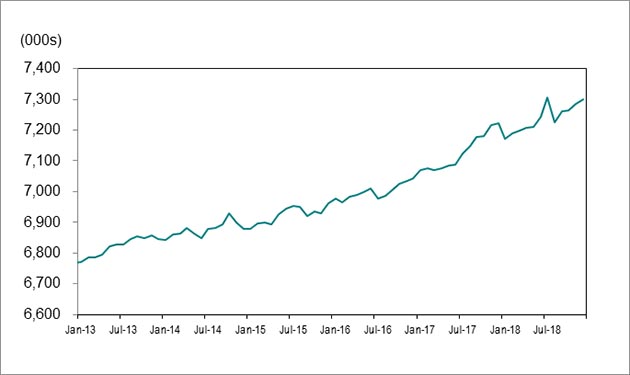
Source: Statistics Canada, Labour Force Survey, Table 14-10-0019-01, (seasonally adjusted data).
Download data, chart 1
Full-time vs. part-time
Part-time jobs increased (29,300), while full-time employment declined (11,600).
Employment increase/decrease by age
Youth employment (those aged 15 to 24) remained steady in December (1,500), after increasing by 3,800 in November.
Employment for people aged 25 to 54 increased by 20,500 in December, compared to November. Those aged 55 and older lost 3,800 jobs.
Employment in Canada was little changed in December (9,300), following the largest increase on record in November (94,100).
Employment in 2018
In 2018, Ontario employment rose by 114,400, compared with 128,400 net new jobs in 2017.
Full-time employment increased by 130,300 in 2018 compared to 2017. Part-time employment fell (15,900).
Nationally, employment increased by 241,100 net new jobs in 2018.
Unemployment rate declined to 5.4%
Chart 2 shows unemployment rates, Ontario and Canada, January 2013 to December 2018.
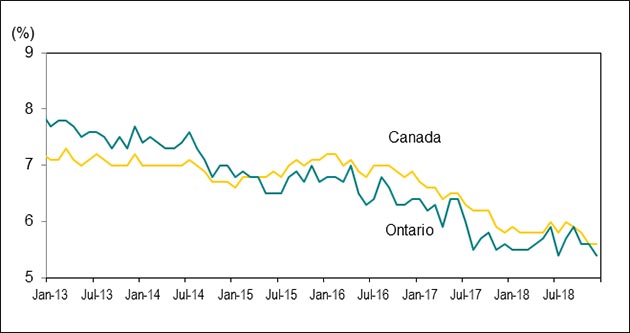
Source: Statistics Canada, Labour Force Survey, Table 14-10-0019-01, (seasonally adjusted data). Download data, chart 2
Ontario’s unemployment rate fell to 5.4% in December from 5.6% in November and has remained below 6.0% since August 2017.
Canada’s unemployment rate was 5.6% in December, matching the lowest rate on record in November.
Unemployment rate by age
For people aged 15 to 24, the unemployment rate was 11.5% in December, down from 12.2% in November.
The unemployment rates for people aged 25 to 54 remained at 4.6% in December compared to November and increased to 4.3% from 4.2% for those aged 55 and older.
Unemployment rate in 2018
Ontario’s unemployment rate fell to 5.6% in 2018 from 6.0% in 2017. Nationally, Canada’s unemployment rate decreased to 5.8% in 2018 from 6.3% in 2017.
Lowest and highest unemployment rates
Chart 3 shows Census Metropolitan Areas (CMAs) with highest and lowest unemployment rates in Canada, December 2018.
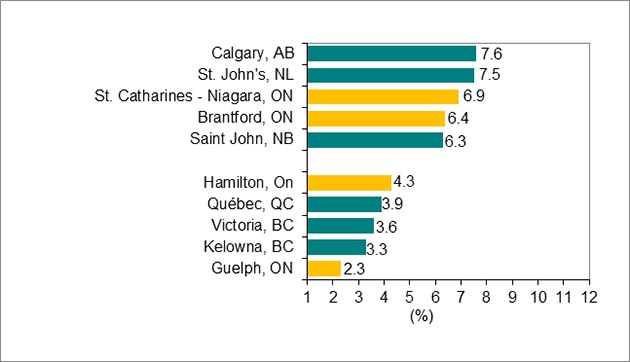
Source: Statistics Canada, Labour Force Survey, Table 14-10-0294-01, (seasonally adjusted data three-month moving average to reduce volatility caused by small sample size).
Download data, chart 3
St. Catharines-Niagara recorded the highest unemployment rate in Ontario (6.9%) in December, while Calgary, Alberta recorded the highest unemployment rate in Canada (7.6%).
Guelph recorded the lowest unemployment rate in Canada in December (2.3%).
2018 and 2017 comparisons
In 2018, employment in Ontario increased by 108,600 net jobs for adults 25 years and older compared to 2017.
Employment increase and decrease by education level
Chart 4 shows Ontario employment change by highest level of education attained, aged 25 and older, 2017 to 2018.
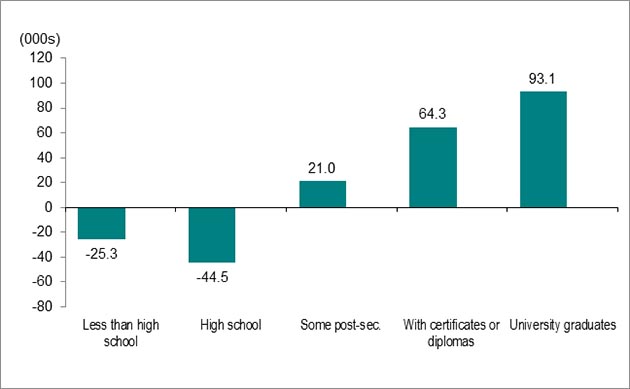
Source: Statistics Canada, Labour Force Survey, Table 14-10-0020-01
Download data, chart 4
Adults with a university degree led gains with 93,100 net new jobs.
Individuals with some postsecondary education recorded job gains of 21,000, while employment for those with certificates or diplomas increased by 64,300.
People with less than high school education recorded job losses of 25,300 and those with high school education recorded job losses of 44,500.
Unemployment rate by education level
The unemployment rate for adults aged 25 and older with postsecondary education credentials was 4.2% in 2018, down from 4.3% a year earlier.
The unemployment rate for adults without postsecondary education credentials was 5.6%, down from 6.3% compared to 2017.
Employment increase and decrease by occupation
Chart 5 shows Ontario employment change by occupation, 2017 to 2018
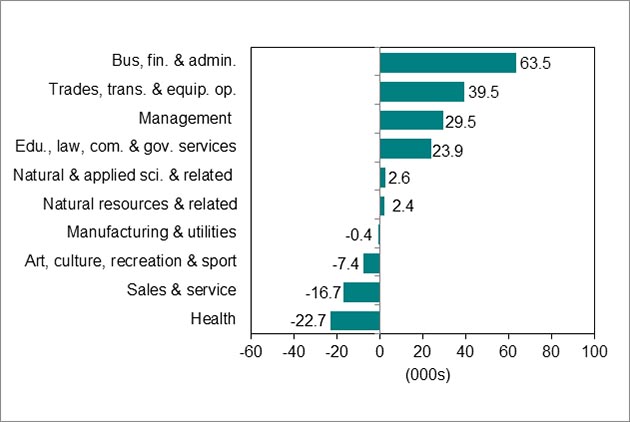
Source: Statistics Canada, Labour Force Survey, Table 14-10-0297-01
Download data, chart 5
Six of the ten major occupational groups in Ontario had net employment gains in 2018 compared to 2017.
Learn more about the National Occupation Classification (NOC) system.
These occupations gained the most jobs:
- business, finance and administration (63,500)
- trades, transport and equipment operators and related (39,500)
- management (29,500)
These occupations lost the most jobs:
- health (22,700)
- sales and service (16,700)
- art, culture, recreation and sport (7,400)
Long-term unemployment decreased
Chart 6 shows Ontario’s long-term unemployed (27 weeks or more) as a percentage of total unemployment, 2010 to 2018
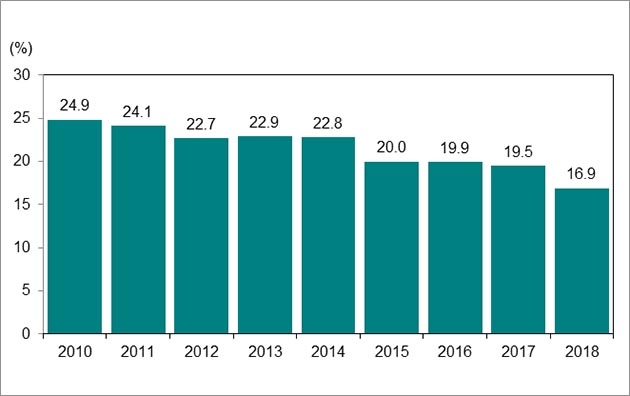
Source: Statistics Canada, Labour Force Survey, Table 14-10-0057-01
Download data, chart 6
In 2018, an average of 72,800 people were long-term unemployed, or unemployed for 27 weeks or longer. This was down from 87,900 a year earlier.
Long-term unemployed individuals accounted for 16.9% of the total number of unemployed people in 2018. This compared with 19.5% a year earlier.
The percentage of long-term unemployed individuals is still higher compared with the
pre-recession level in 2008, when 13.7% of all unemployed people were long-term unemployed.
Average time in long-term unemployment
The average time in unemployment decreased to 17.2 weeks in 2018 from 19.2 weeks a year earlier.
Download data
Source: Statistics Canada, Labour Force Survey
December 2018 Labour Market Report:
- CSV, Chart 1, employment in Ontario from January 2013 to December 2018, 1Kb
- CSV, Chart 2 unemployment rates, Ontario and Canada, January 2013 to December 2018, 2Kb
- CSV, Chart 3 Census Metropolitan Areas (CMAs) highest and lowest unemployment rates, 2Kb
- CSV, Chart 4, Ontario employment change by highest level of education, aged 25 and older, 99Kb
- CSV, Chart 5, Ontario employment change by occupation 12Kb
- CSV, Chart 6, Ontario’s long-term unemployed, 15Kb